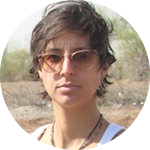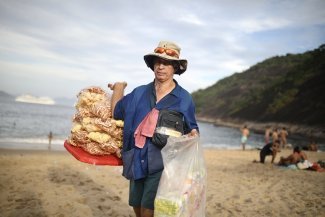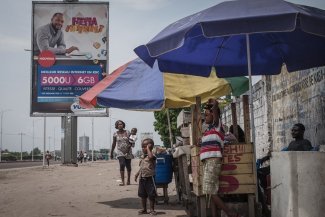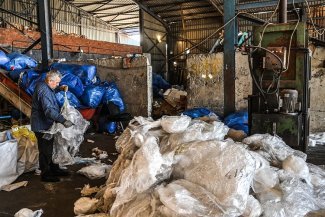A pilot project in the Madre de Dios River region of the Peruvian Amazon was one of the first pilot projects financed by the brand-new International Land and Forest Tenure Facility.
Indigenous peoples and other local communities play a vital role when it comes to mitigating the impact of climate change. But despite inhabiting 50 per cent of the world’s land, these communities legally own just 10 per cent of it. As a result, civil society groups are calling on governments around the world to scale up the protection of customary land rights.
The lands managed by community groups serve as important carbon sinks by allowing standing forests to work as reservoirs, absorbing CO2 and preventing its harmful emission into the atmosphere. In fact, collectively, the world’s forests store more carbon than is currently present in the atmosphere. If indigenous communities are not given legal recognition and government protection, and the current rate of deforestation continues unabated, these forests are likely to become a dangerous source of CO2 emissions.
Julio Ricardo Cusurichi Palacios, a Shipibo indigenous leader from Peru and the winner of the 2007 Goldman Prize for grassroots environmental activism, told Equal Times that the solution lies in genuine community engagement. “We want to have a bottom-up approach rather than an imposed one, so that we can collectively offer solutions,” he said.
A 2016 research project conducted by Rights and Resources Initiative (RRI) revealed that indigenous and community forest lands hold at least one-quarter of all above-ground tropical forest carbon (54,546 million metric tonnes of carbon, or MtC), a sum 250 times greater than the amount of CO2 emitted by global air travel in 2015.
And because of instances where the formal recognition of indigenous or community land ownership is absent, over 22.3 million MtC are at risk of being released through illegal logging, land grabbing and other deforestation drivers such as grazing, mining and agricultural practices such as palm oil cultivation.
Andy White, coordinator of RRI, is calling for the reinforcement of “collective tenure security” for the sustainable use and protection of the world’s rainforests and the carbon they sequester.
“[Indigenous and community] forests hold four times the entire amount of carbon that human activity sent into our planet’s atmosphere in 2014,” he said. In addition, almost 2.5 billion people – a third of the planet’s population – depend on community-held lands for their livelihoods. Titling enables these people to be less vulnerable and more food secure.
“Study after study has found that indigenous peoples and communities do the best job of stopping deforestation and keeping the trees upright, even better than established protected areas,” White said. “Their forests hold back the worst of what climate change can throw at us.”
Rights-based approaches to climate change action
Of the total 54.5 million MtC stored in tropical collective forestlands, more than half is in Latin America – 30 million MtC – most notably in Brazil, Colombia and Peru. Sub-Saharan Africa is also an important reservoir (8.3 million MtC), particularly the Democratic Republic of Congo, Angola and Cameroon.
Ahead of this year’s annual UN Climate Change Conference in Bonn (COP23) a delegation of community leaders from Latin America, Africa and south-east Asia embarked on a bus tour of Europe’s capital cities. They sought recognition of their role to conserve rainforests and to advocate the need to promote rights-based approaches to climate change action.
The expedition started on 24 October at the Royal Society in London, where they made an urgent call for more investment in forests in a bid to eliminate deforestation, and launched the first study to calculate the global state of forest finance.
Out of US$167 billion in international development finance committed since 2010 to reduce carbon emissions, only 2 per cent (US$3.6 billion) has been dedicated to curb deforestation. Data shows that protecting forests can deliver as much as 30 per cent of the climate change mitigation needed to meet the Paris Agreement goals.
The Brazilian Sonia Guajajara, a strong voice of the indigenous organisations in the Amazon Basin, was outspoken during the launch of the expedition:
“We are the ones standing in the path of the rampant deforestation brought on by the global hunger for soy, beef, palm oil, paper and timber. And we are the ones being murdered for protecting our forests. If you want to stop devastation, you need to invest in us and in protecting our rights. The mother of all battles is going on in the rainforest,” she declared.
Indigenous lands on the front line
Campaigners agree that finance poses a massive challenge. “We need to invest more in trees,” said Nancy Harris, the US research manager at Global Forest Watch. “If we are serious about meeting the Paris Agreement, we need to funnel finance to conserving and restoring forests.”
To this end, a new initiative, the International Land and Forest Tenure Facility, was launch in Stockholm last month in a bid to help fund the efforts of indigenous and local communities to secure title to their lands and access their resources.
The Tenure Facility is funded by multiple donors such as the Swedish and Norwegian agencies for international development cooperation and the Ford Foundation. It is the world’s first and only funding institution dedicated to supporting indigenous in securing their land rights.
The pilot phase involved six projects across Africa, Asia and Latin America that received financial and technical assistance. Communities from Cameroon, Indonesia, Liberia, Mali, Panama and Peru scaled up their efforts for demarcating their territories, as well as accelerated the implementation of laws and policies. In this incubation stage, they were able to advance rights over two million hectares of forest lands.
The highly diverse region of Madre de Dios in the Peruvian Amazon, home to 36 indigenous communities, was among the pilots selected. Many of these communities require legal clarification of their land.
FENAMAD, an organisation run by the Goldman Prize-winning indigenous leader Julio Ricardo Cusurichi Palacios, was able to consolidate land use plans for five indigenous communities covering 60,000 hectares and home to a population of 900 people. But there is still a long way to go. “We are searching for allies who can help us to engage in the promotion and respect of our rights,” he said, particularly at a local and federal government level.
The Tenure Facility has generated dialogue and negotiation, according to its director, Nonette Royo but more needs to be done. “Indigenous peoples have realised that even if their [national] constitutions recognise their existence, they don’t have the recognition of their rights. Many of them have experienced being removed out of the land they have lived on for generations because they have no proof of land title.” If nations are not careful, Royo warns, “we will lose the last remaining communities that really care about the integrity of the forests.”
In the next decade, the facility will spend US$10 million a year on projects that aim to increase titled, protected and well-managed community and indigenous forest lands covering 40 million hectares. That could prevent the emission of 0.5 gigatons of CO2 and the deforestation of at least one million hectares.
In addition, a new platform for indigenous peoples was created by the Paris Agreement. During the recent COP23, Patricia Espinosa, the executive secretary of the UN Framework Convention on Climate Change (UNFCCC), called for its augmentation.
“This platform recognises that indigenous are particularly vulnerable [to climate change] but are also providers of solutions with their ancestral knowledge. It will be a permanent space so they can influence in the climate agenda,” she told reporters in Bonn.










